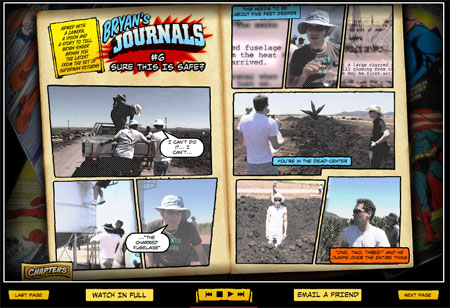Links & News – 30. November
The news-bytes for today:
Study Predicts Spending Shift Away From TV
video ad growth is at a tipping point
The news-bytes for today:
video ad growth is at a tipping point
Superman returns in 2006. And Warner Brothers has employed a number of online tools to promote the new film. From the main website you get to all the subsites:

So there is a lot of stuff on the web for people to get engaged with.
And, as a sidenote: that they are also doing TV commercials for this Movie is a bit pointless, says AdJab, however in a different context.
The first Links & News is all about advergames:
(all via adverblog)
In a previous entry, I wrote about the new Nike campaign showing Ronaldinho doing some „magic“ tricks with his new Nike shoes. Now the German Spiegel Online writes, that Ronalinho’s ping pong shots are actually not all real. Apparently Nike Europe admits, that only two out of the four shots are real, the other being reworked on the computer!
While the video remains nice to watch even knowing about this fake, I am still rather disappointed. We’re used to „unreal“ ads, no doubt. But this particular one was interesting, especially because of the amazing ping pong shots.
Or am I upset, because I believe that viral ads published on the web should have more integrity than ads on TV? Not sure…
Amazon continues to set standards in e-commerce. Now they have introduced a wiki for the product descriptions. So users cannot only rate and comment the products, they can also add detail to the product features. More info and some screenshots can be found here and here.
As not all user can see this (I can’t either), this still seems to be in beta.
However, what I could see, was the link for tagging. Not sure for how long amazon.com had this, as I usually buy on amazon.de – and the German version usually gets the new features a lot later (the newest feature being: search inside the book! For how long did amazon.com have this already?)
With the tags, you can organise the amazon content your way, and:
Because people’s tags are (by default) visible to others, a great side effect of tagging is that you can navigate among items through other people’s tags. What items have people tagged „gift“ or „Tuscany“ or „robot?“
Nice concept of commercially using two feaures associated with the so called web 2.0!
Forbes has created an E-Mail Time Capsule. You can write an email that will be sent in either 1, 3, 5, 10 or 20 years depending on your choice. Be quick, the time capsule closes on the 30th of November (this year!).
Forbes and their partners Yahoo! and Codefix have implemented a redundant networking system for making sure, that within 20 years, given that at least one of them sticks around, can send out the emails of the capsule, as Forbes writes.
I am just glad they added a code in an image you have to enter (as you have these days in blogs comments, etc.), so that nobody can mass-spam anybody.
Imagine receiving emails from, say, the ULTIMATE PHARMACY ONLINE, about Viagra – in 2023 – just to remember that Phizer went out of business some 15 years ago because some other stupid drug was invented?
And who says we even have Email in 20 years? We didn’t have it 20 years ago.
Think about it: what if someone had done a time capsule for Telex some 20-30 years ago? I can’t think of any company or person who still uses Telex Technology.
With IM and mobile messaging booming – maybe we wont have Email in 20 years? (Or just our parents – the grandparent generation – uses it. Sort of like now, where most of the handwritten letters you get are from your grandparents.
Further to my post below there was a Clickz article about Seven Digital Consumer Trends plus some insights into what that means for marketing, etc.
(It’s from June 2006, but I only remembered about it again now.)
Individuals‘ interconnectivity is increasing. The information playing field is being leveled. Relevance filtering is growing. Niche aggregation is growing. Micropublished self-expression is blossoming. The „prosumer“ is rising. It’s on-demand everything, everywhere.
What that means?
They’re better informed through the increased ability to access and sift an abundance of information anytime, anywhere. They’re better connected through the ability to instantaneously communicate with others across time zones and social strata. They’re more communicative through the ability to publish and share their ideas and opinions. They’re more in control through the ability not only to personalize their information and entertainment consumption, marketing messages, and the products and services they buy, but also to gain satisfaction on demand.
As this evolution continues, marketers are faced with a growing number of challenges to acquire, satisfy, and keep their target customers. They must rethink their approach to brand communications.